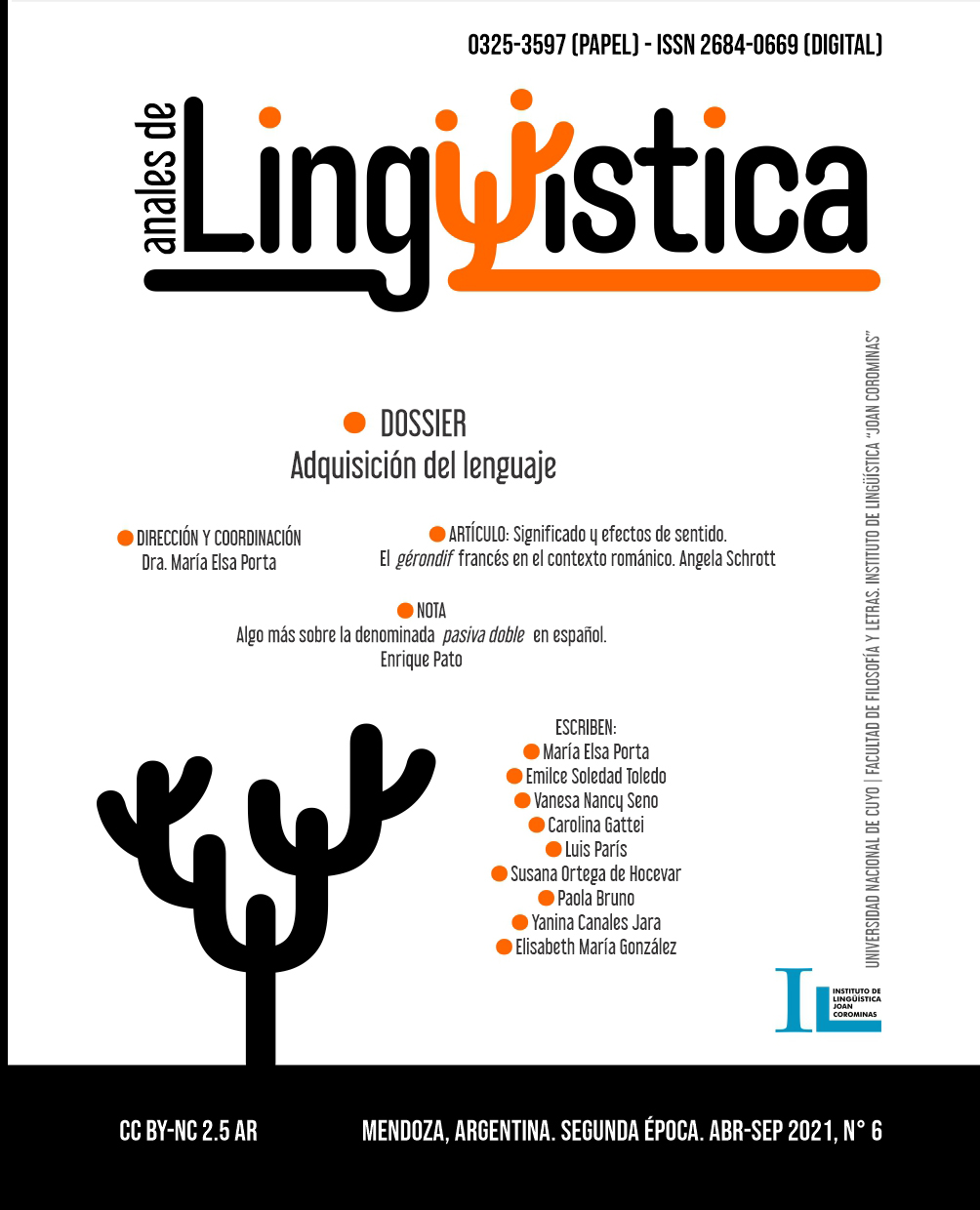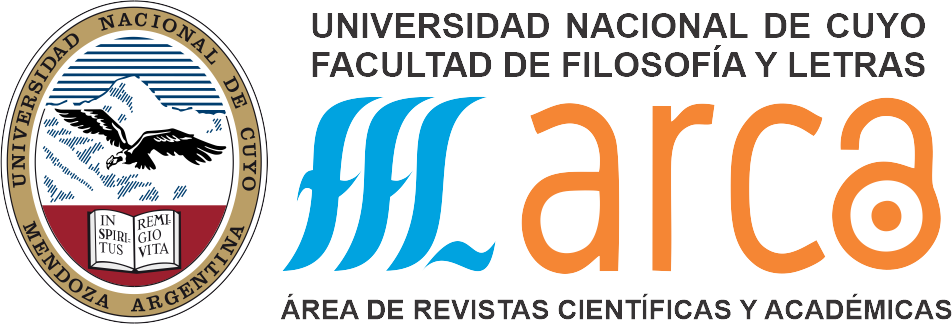Effect of socio-environmental variables on kindergarteners’ phonological awareness skills
Keywords:
Socio-environmental variables, Phonological awareness, Urban and urban marginal gardensAbstract
Studies that analyze the linguistic differences related to the literacy process in schoolchildren from different socio-economic levels, suggest that they are related to the literacy level of the family and social environment in which children grow up (Borzone et al. 2005). The objectives of the work are: to investigate if there are linguistic differences in phonological awareness skills such as: identification of rhyme and initial phoneme, segmentation of syllables in words and integration of sounds, in children of Initial Level of the province of Mendoza, of urban public gardens (U) and urban marginal gardens (UM), and determine if the origin of these differences are due to the socio-environmental variables, educational level (NE) and socioeconomic level (SES) of the household. During the school year (2016), 170 schoolchildren aged 4 and 5, of both sexes, from U (n = 83) and UM (n = 87) kindergartens were evaluated. The NE of the parents was calculated according to data from the school records and the SES according to data from INDEC 2008. The ANOVA showed, on the one hand, a significant effect of age on the phonological awareness skills evaluated, the 5-year-old children having a response level higher than 4-year-olds. And on the other hand, for both socio-environmental variables a significant effect of the area of origin was observed: the NE of children who attend U Gardens was higher than that of children who attend UM gardens; in addition, the SES of children from U gardens was higher than that of children from UM gardens.
References
Borzone, A.M., Diuk, B. (2001). El aprendizaje de la lectura en español: estudio comparativo entre niños de distinta procedencia social. Interdisciplinaria, 18(1), 35-63.
Borzone, A., Rosemberg, C., Diuk, B. y Amado, B. (2005). Aprender a leer y a escribir en contextos de pobreza. Lingüística en el aula, 9, 7-28.
Bradley, L. & Bryant, P. (1983). Categorizing sounds and learning to read. A causal connection. Nature, 301, 419-421.
Bronfenbrenner, U. (1995). Developmental ecology through space and time: A future perspective. En: P. Moen, G. H. Elder, Jr., y K. Lüscher (Eds.). Examining lives in context: Perspectives on the ecology of human development (p. 619–647). American Psychological Association. doi.org/10.1037/10176-018.
Canales Jara, Y. y Porta, M.E. (2016). El nivel educativo y socioeconómico del hogar y habilidades prelectoras en escuelas urbanas y urbano-marginales de la provincia de Mendoza-Argentina. Actualidades Investigativas en Educación, 16 (2), 1-26.
Canales Jara,Y., Porta, M.E. (2020). Un estudio comparativo sobre el nivel de habilidades lingüísticas de niños de 4 y 5 años de escuelas urbanas y urbano- marginales. Psicopedagógica, 10 (13), 117-151.
Catts, H. W., Fey, M.E., Zhang, X., Tomblin, J.B. (2001). Estimating the Risk of Future Reading Difficulties in Kindergarten Children: A Research-Based Model and Its Clinical Implementation. Language Speech and Hearing Services in Schools, 32(1), 38-50.
Dearing, E., McCartney, K., Weiss, H., Kreider, H. & Simpkins, S. (2004). The promotive effects of family educational involvement for low-income children's literacy. Journal of School Psychology, 42 (6), 445-460.
Dickinson, D. & Tabors, P. (2001). Beginning literacy with language. Young children learning at home and school. Baltimore: Paul H. Brookes Publishing.
Dickinson, D. K., McCabe, A., Anastasopoulos, L., Peisner-Feinberg, E. S., y Poe, M. D. (2003). The comprehensive language approach to early literacy: The interrelationships among vocabulary, phonological sensitivity, and print knowledge among preschool- aged children. Journal of Educational Psychology, 95(3), 465–481. doi.org/10.1037/0022-0663.95.3.465.
Dickinson, D. K. y Caswell, L. (2007). Building support for language and early literacy in preschool classrooms through in-service professional development: Effects of the Literacy Environment Enrichment Program (LEEP). Early Childhood Research Quarterly, 22(2), 243-260.
Dunn, LL. M., Padilla, E. R., Dunn, L. M, (1986). Test Vocabulario en Imágenes, Peabody. Adaptación hispanoamericana. Edición en español. España: TEA.
Ehri, L. C., Nunes, S. E., Willows, D. M., Schuster, V. B., Yaghoub- Zadeh, Z., Shanahan, T. (2001). Phonemic awareness instruction helps children learn to read: Evidence from the National Reading Panel's meta-analysis. Reading Research Quarterly, 36(3), 250- 287.
Filippetti, V. (2012). Estrato Socioeconómico y Habilidades Cognitivas en Niños Escolarizados: Variables Predictoras y Mediadoras. Psykhe, 21(1), 3-20.
United Nations International Children's Emergency Fund (2007). Propuestas para superar el fracaso escolar [Approach to overcome school failure] Bs As: UNICEF. Recuperado el 1 de marzo de 2015, de http://www.unicef.org/argentina/spanish/ PROPUESTA_web.pdf.
Galicia Moneda, I. X., Sánchez Velasco, A., Pavón Figueroa, S. y Peña Flores, T. (2009). Habilidades psicolingüísticas al ingreso y egreso del jardín de niños. Revista Intercontinental de Psicología y Educación,11(2),13-36.
Ghiglion, M. E., Filippetti A., V., Manucci, V., Apaz, A. (2011) Programa de Intervención para fortalecer funciones cognitivas y lingüísticas adaptado al currículo escolar en niños en riesgo por pobreza. Interdisciplinaria, 28.
Guevara, Y., Hermosillo, A., Delgado, U., Lopez, A. y García, G. (2007). Nivel pre académico de alumnos que ingresan a primer grado de primaria. Revista Mexicana de Investigación Educativa, 12, (32), 405-434.
Guevara, Y., García, G., López, A., Delgado, U. y Hermosillo, A. (2007). Habilidades lingüísticas en niños de estrato sociocultural bajo, al iniciar la primaria. Acta Colombiana de Psicología, 10(2), 9-17.
Hart, B. y Risley, T. R. (1995). Meaningful differences in the everyday experience of young American children. Baltimore, MD: Paul H. Brookes Publishing Company.
Hoff, E. (2003). The Specificity of Environmental Influence: Socioeconomic Status Affects Early Vocabulary Development Via Maternal Speech. Child Development, 74(5), 1368-1378. INDEC. Sistemas de estadísticas Sociodemográficas. Área Educación. Definiciones y Conceptos. Recuperado el 1 de enero de 2008 de https://www.indec.gob.ar/ftp/ indecinforma/nuevaweb/cuadros/7/sesd_glosario.pdf
Jadue J, Gladys. (1997). Factores ambientales que afectan el rendimiento escolar de los niños provenientes de familias de bajo nivel socioeconómico y cultural. Estudios pedagógicos (Valdivia), (23), 75-80. doi.org/10.4067/S0718-07051997000100007.
Jiménez G., J. E. y Ortiz G., M. del R. (1999). Conciencia fonológica y aprendizaje de la lectura: Teoría, evaluación e intervención. Madrid: Síntesis S.A.
Kirk, S.A; Mc Carthy, J.J y Kirk, W.D., (2011). Test Habilidades Psicolingüísticas: ITPA Test Illions de Aptitudes Psicolingüísticas. 8a Edición. España.
López, L. M. y Tabors, P., Páez, M., (2002). Phonological Awareness Test.
Marder, S.E y Borzone, A.M. (2016). El cerebro convoca al mundo social del niño. Bases del programa de alfabetización Leamos Juntos para el desarrollo cognitivo y lingüístico en la primera infancia. Revista Ibero-americana de Educação, 72, 147-168.
Noble K. G., McCandliss B. D. y Farah M. J. (2006), Socioeconomic background modulates cognition–achievement relationships in Reading. Cognitive Development, 21, 349–368.
Noble K. G., McCandliss B. D., Farah M. J. (2007), Socioeconomic gradients predict individual differences in neurocognitive abilities. Developmental Science, 10(4), 464– 480.
United Nations Educational Scientific and Cultural Organization (2019). Education: Repeaters in primary education. Recuperado el 26 de septiembre de 2019 de http://data.uis.unesco.org.
Piacente, T., Marder, S., Resches y M., Ledesema, R. (2006). El contexto alfabetizador hogareño en familia de la pobreza. Comparación de sus características con las de familias no pobres. Revista Iberoamericana de Diagnóstico y Evaluación Psicológica, 1 (21), 61-88.
Porta, M.E. (2008). Hacia un enfoque comprehensivo del aprendizaje lingüístico inicial. Implementación del modelo y evaluación de sus efectos sobre el rendimiento lector. Tesis doctoral no publicada. Universidad Nacional de Cuyo, Mendoza, Argentina.
Porta, M. E. y Difabio de A., H. (2009). Detección oportuna de niños en riesgo pre- lector. Ponderación del valor potencial de instrumentos de evaluación de la consciencia fonológica. Revista de Psicología. UCA. (5), 9, 55-77.
Porta, María, Rosemarie Kraft y Lawrenece Harper (2010). Hemispheric asymmetry profiles during beginning reading: Effects of reading level and word type. Developmental Neuropsychology, 35(1): 96-114.
Porta, M. E., Ison, M. (2011). Hacia un enfoque comprehensivo del aprendizaje lingüístico inicial como proceso cognitivo. Revista Iberoamericana de Educación, 55, 243-260.
Ratazzi, A.; de Fox, S. y Peire, J. (2015). Desarrollo cerebral y neuroplasticidad (Cap.3). En: M. E. de Podestá, A. Ratazzi, S. de Foz y J. Peire Josefina Peire (comp.). El cerebro que aprende. Buenos Aires: Aique.
Wiig, E. H., Secord, W. A. y Semel, E., (2009). Test Celf Preschool 2. Clinical Evaluation of Language Fundamentals Preschool 2 - Spanish Edition. San Antonio, TX: Pearson.
Downloads
Published
How to Cite
Issue
Section
License
Copyright (c) 2021 Anales de Lingüística
Esta obra está bajo una Licencia Creative Commons Atribución 2.5 Argentina.
Los/as autores/as que publican en esta revista están de acuerdo con los siguientes términos:
1. Los/as autores conservan los derechos de autor y garantizan a la revista el derecho de ser la primera publicación del trabajo bajo una licecncia Creative Commons Atribución 2.5 Argentina (CC BY 2.5 AR) . Por esto pueden compartir el trabajo con la referencia explícita de la publicación original en esta revista.
2. Anales de lingüística permite y anima a los autores a difundir la publicación realizada electrónicamente, a través de su enlace y/o de la versión postprint del archivo descargado de forma independiente.
3. Usted es libre de:
Compartir — copiar y redistribuir el material en cualquier medio o formato
Adaptar — remezclar, transformar y construir a partir del material para cualquier propósito, incluso comercialmente.












